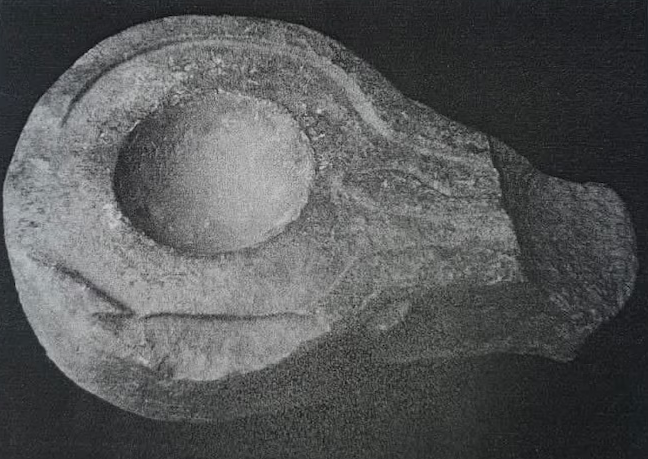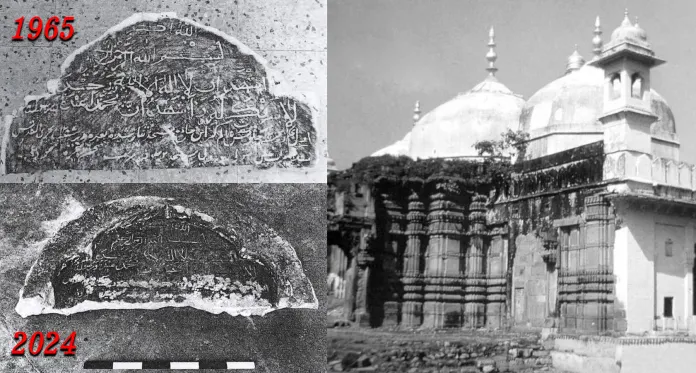Governance
ASI Survey Report on Gyanvapi Mosque
- 30 Jan 2024
- 11 min read
For Prelims: ASI Survey Report on Gyanvapi Mosque, Archaeological Survey of India (ASI), Gyanvapi mosque, Carbon Dating, The Places of Worship Act, 1991.
For Mains: ASI Survey Report on Gyanvapi Mosque, Salient aspects of Art Forms, Literature and Architecture from ancient to modern times.
Why in News?
Recently, the Archaeological Survey of India (ASI) surveyed the Gyanvapi mosque complex, where a total of 55 stone sculptures were found, including the idols of Hindu Deities.
- The ASI report suggests that a temple "appears to have been destroyed in the 17th century, during the reign of Aurangzeb, and part of it was modified and reused in the existing structure."
What are the Key Highlights of the ASI Report?
- Discovery of Broken Idols:
- The survey uncovered fragments of what appear to be statues of Hindu Deities, including those of Hanuman, Ganesha, and Nandi, within the mosque complex.
- Various sculptures and statues were found in varying states of damage, including those of Shiva linga, Vishnu, Ganesha, Krishna, and Hanuman.
- Yonipattas and Shiv Linga:
- Several yonipattas, the base of a shivling, were discovered during the survey.
- A shiv linga with its bottom part missing was also found.
- Indian Inscription:
- 32 inscriptions written in the Devanagari, Grantha, Telugu and Kannada scripts.
- These are in fact inscriptions on the stone of a preexisting Hindu temple which have been reused during the construction, repair of the existing structure.
- The reuse of earlier inscriptions in the structure suggests that the earlier structures were destroyed and their parts were reused in the construction and repair of the existing structure.
- Swastik and Trident Marks:
- There were marks found on the structure, including the swastika and the trident.
- Swastika is known to be one the most ancient symbols in the world, and has been used in all old civilisations.
- Trishula (trident -- the distinct weapon of Lord Shiva), symbol is commonly used as one of the principal symbols by Hindus, particularly by Shaivites and also Shaktas.
- There were marks found on the structure, including the swastika and the trident.
- Coins and Sandstone Slab with Persian Inscription:
- Objects such as coins, a sandstone slab inscribed in Persian, and other artifacts were unearthed during the survey.
- Inscriptions in Persian on stone slabs were found, providing an account of the demolition of the temple during the reign of Mughal Emperor Aurangzeb in the 17th century.
What is the Archaeological Survey of India (ASI)?
- ASI, under the Ministry of Culture, is the premier organisation for the archaeological research and protection of the cultural heritage of the nation.
- Ancient Monuments and Archaeological Sites and Remains (AMASR) Act, 1958 governs the functioning of ASI.
- It administers more than 3650 ancient monuments, archaeological sites and remains of national importance.
- Its activities include carrying out surveys of antiquarian remains, exploration and excavation of archaeological sites, conservation and maintenance of protected monuments etc.
- It was founded in 1861 by Alexander Cunningham- the first Director-General of ASI. Alexander Cunningham is also known as the “Father of Indian Archaeology”.
What Method was Used in the Survey at Gyanvapi Mosque?
- The ASI has conducted a detailed non-invasive survey of the Gyanvapi mosque in Varanasi to determine if the mosque was built atop a temple.
- Non-invasive methods are used when investigations are undertaken inside a built structure and no excavation is permitted.
- Types of Methods:
- Active Methods: Inject energy into the ground and measure the response. The methods provide an estimate of the ground’s material properties, such as density, electrical resistance, and wave velocity.
- Seismic Techniques: Use shock waves to study subsurface structures.
- Electromagnetic Methods: Measure electromagnetic responses after energy injection.
- Passive Methods: Measure existing physical properties.
- Magnetometry: Detect magnetic anomalies caused by buried structures.
- Gravity Surveying: Measure gravitational force variations due to subsurface features.
- Ground-Penetrating Radar (GPR):
- ASI used GPR to produce a 3-D model of buried archaeological features.
- GPR operates by introducing a short radar impulse from a surface antenna and records time and magnitude of return signals from the subsoil.
- Radar beam spreads like a cone, causing reflections before the antenna passes over the object.
- Radar beams spread out in a cone, leading to reflections that may not directly correspond to physical dimensions, creating false images.
- Carbon Dating:
- Method used to establish the age of organic materials based on the radioactive decay of Carbon-14 (C-14).
- Active Methods: Inject energy into the ground and measure the response. The methods provide an estimate of the ground’s material properties, such as density, electrical resistance, and wave velocity.
What is the Gyanvapi Mosque Dispute?
- Demolition of Temple:
- It is a popular belief that the Gyanvapi Mosque was built in 1669 by the Mughal ruler Aurangzeb by demolishing the ancient Vishweshwar temple.
- Saqi Mustaid Khan’s Maasir-i-Alamgiri, a Persian-language chronicle (written shortly after Aurangzeb’s death in 1707) also mentioned that Aurangzeb had demolished the temple in 1669 by ordering Governor Abul Hassan.
- The ASI report stated that the Arabic-Persian inscription found inside a room in the mosque mentions that the mosque was built in the 20th regal year of Aurangzeb (1676-77 CE).
- Historian Audrey Truschke wrote that Aurangzeb brought the bulk of Benares’s Vishvanatha Temple (Vishweshwar) down in 1669. The temple had been built during Akbar’s reign by Raja Man Singh, whose great-grandson, Jai Singh, many believed helped Shivaji flee from the Mughal court in 1666.
- It is a popular belief that the Gyanvapi Mosque was built in 1669 by the Mughal ruler Aurangzeb by demolishing the ancient Vishweshwar temple.
- Legal Battle:
- The case of Gyanvapi mosque has been in court since 1991, when three persons, including a descendant of the priests of the Kashi Vishwanath temple, filed a suit in the court of the civil judge of Varanasi claiming that Aurangzeb had demolished the temple of Lord Vishweshwar and built a mosque on it so that the land should be returned to them.
- On 18th August 2021, in the same court in Varanasi, five women filed a petition demanding to worship in the temple of Mata Shringar Gauri, accepting which the court constituted a commission to know the present status of the Mata Shringar Gauri Temple.
- Varanasi court had asked the Commission to give the survey report by videographing the idol of Mata Shringar Gauri and the Gyanvapi complex.
- The Hindu side has presented a comprehensive map of the Gyanvapi complex as evidence in court. This map identifies Hindu deity temples located around the mosque entrance, along with landmarks such as the Vishweshwar temple, Gyankoop (Mukti Mandap), the prominent Nandi statue, and the Vyas family basement.
- The Muslim side argued that no decision can be given on the dispute under the The Places of Worship Act, 1991.
- Under Section 3 of the Places of Worship (Special Provisions) Act, 1991, it is prohibited to convert a place of worship into a place of worship of a different religious denomination or a different class of the same religious denomination.
- Gyanvapi Case is still pending before judiciary.
What are the Provisions of the the Places of Worship Act 1991?
- Prohibition of Conversion (Section 3):
- Prevents the conversion of a place of worship, whether in full or part, from one religious denomination to another or within the same denomination.
- Maintenance of Religious Character (Section 4(1)):
- Ensures that the religious identity of a place of worship remains the same as it was on 15th August 1947.
- Abatement of Pending Cases (Section 4(2)):
- Declares that any ongoing legal proceedings concerning the conversion of a place of worship's religious character before15th August 1947, will be terminated, and no new cases can be initiated.
- Exceptions to the Act (Section 5):
- The Act does not apply to ancient and historical monuments, archaeological sites, and remains covered by the Ancient Monuments and Archaeological Sites and Remains Act, 1958.
- It also excludes cases that have already been settled or resolved and disputes that have been resolved by mutual agreement or conversions that occurred before the Act came into effect.
- The Act does not extend to the specific place of worship known as Ram Janmabhoomi-Babri Masjid in Ayodhya, including any legal proceedings associated with it.
- Penalties (Section 6):
- Specifies penalties, including a maximum imprisonment term of three years and fines, for violating the Act.








